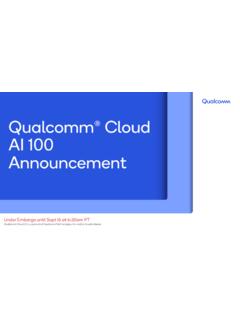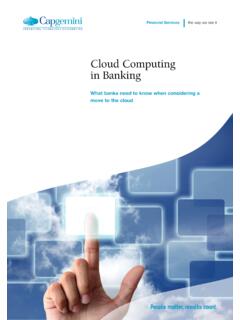Transcription of Introduction to Cloud Computing - DialogicInc
1 White PaperIntroduction to Cloud ComputingIntroduction to Cloud Computing2 White PaperExecutive SummaryA common understanding of Cloud Computing is continuously evolving, and the terminology and concepts used to define it often need clarifying. Press coverage can be vague or may not fully capture the extent of what Cloud Computing entails or represents, sometimes reporting how companies are making their solutions available in the Cloud or how Cloud Computing is the way forward, but not examining the characteristics, models, and services involved in understanding what Cloud Computing is and what it can white paper introduces internet-based Cloud Computing , exploring the characteristics, service models, and deployment models in use today.
2 As well as the benefits and challenges associated with Cloud Computing . Also discussed are the communications services in the Cloud (including ways to access the Cloud , such as web APIs and media control interfaces) and the importance of scalability and flexibility in a Cloud -based environment. Also noted for businesses desiring to start using communication services, are the interface choices available, including Web APIs, media control interfaces, Java interfaces, and XML based interfaces, catering to a wide range of application and service creation to Cloud Computing3 White PaperTable of ContentsIntroduction.
3 4 Cloud Computing ..4 Characteristics ..4 Service Models ..5 Deployment Models ..5 Benefits ..6 Challenges ..6 Communications in the Cloud ..6 Using the Communications Services ..7 Accessing through Web APIs ..7 Media Server Control Interfaces ..7 Communications Scalability ..8 Getting Started with Communications Services ..8 Introduction to Cloud Computing4 White PaperIntroductionThis white paper is an Introduction to the terms, characteristics, and services associated with internet-based Computing , commonly referred to as Cloud Computing .
4 Characteristics, such as infrastructure, provisioning, network access, and managed metering are presented . The primary business service models being deployed (such as software, platform, and infrastructure as a service) and common deployment models employed by service providers and users to use and maintain the Cloud services (such as the private, public, community, and hybrid clouds) are discussed . Also introduced are the benefits and challenges associated with Cloud Computing , and for those seeking to use communications services in the Cloud , briefly presented are different ways of determining the interfaces needed to use these communications services.
5 Cloud ComputingThe term Cloud , as used in this white paper, appears to have its origins in network diagrams that represented the internet, or various parts of it, as schematic clouds . Cloud Computing was coined for what happens when applications and services are moved into the internet Cloud . Cloud Computing is not something that suddenly appeared overnight; in some form, it may trace back to a time when computer systems remotely time-shared Computing resources and applications . More currently though, Cloud Computing refers to the many different types of services and applications being delivered in the internet Cloud , and the fact that, in many cases, the devices used to access these services and applications do not require any special applications.
6 Many companies are delivering services from the Cloud . Some notable examples include the following: Google Has a private Cloud that it uses for delivering Google Docs and many other services to its users, including email access, document applications, text translations, maps, web analytics, and much more . Microsoft Has Microsoft Office 365 online service that allows for content and business intelligence tools to be moved into the Cloud , and Microsoft currently makes its office applications available in a Cloud .
7 Runs its application set for its customers in a Cloud , and its Force .com and Vmforce .com products provide developers with platforms to build customized Cloud services .But, what is Cloud Computing ? The following sections note Cloud and Cloud Computing characteristics, services models, deployment models, benefits, and challenges .CharacteristicsCloud Computing has a variety of characteristics, with the main ones being: Shared Infrastructure Uses a virtualized software model, enabling the sharing of physical services, storage, and networking capabilities.
8 The Cloud infrastructure, regardless of deployment model, seeks to make the most of the available infrastructure across a number of users . Dynamic Provisioning Allows for the provision of services based on current demand requirements . This is done automatically using software automation, enabling the expansion and contraction of service capability, as needed . This dynamic scaling needs to be done while maintaining high levels of reliability and security . Network Access Needs to be accessed across the internet from a broad range of devices such as PCs, laptops, and mobile devices, using standards-based APIs (for example, ones based on HTTP).
9 Deployments of services in the Cloud include everything from using business applications to the latest application on the newest smartphones . Managed Metering Uses metering for managing and optimizing the service and to provide reporting and billing information . In this way, consumers are billed for services according to how much they have actually used during the billing period . In short, Cloud Computing allows for the sharing and scalable deployment of services, as needed, from almost any location, and for which the customer can be billed based on actual usage.
10 Introduction to Cloud Computing5 White PaperService Models Once a Cloud is established, how its Cloud Computing services are deployed in terms of business models can differ depending on requirements . The primary service models being deployed (see Figure 1) are commonly known as: Software as a Service (SaaS) Consumers purchase the ability to access and use an application or service that is hosted in the Cloud . A benchmark example of this is Salesforce .com, as discussed previously, where necessary information for the interaction between the consumer and the service is hosted as part of the service in the Cloud .





